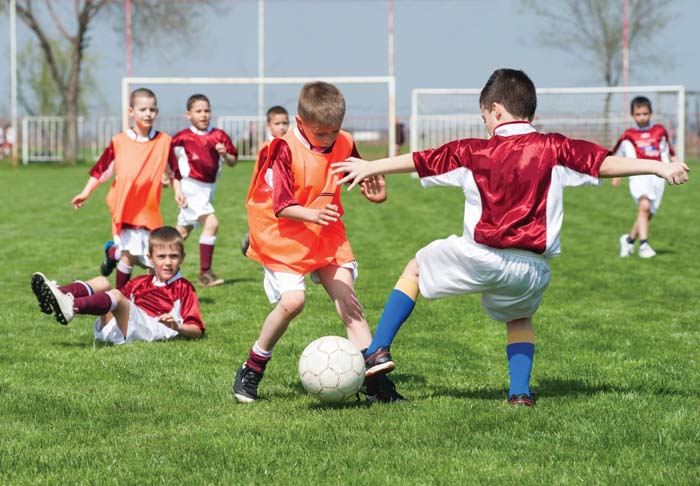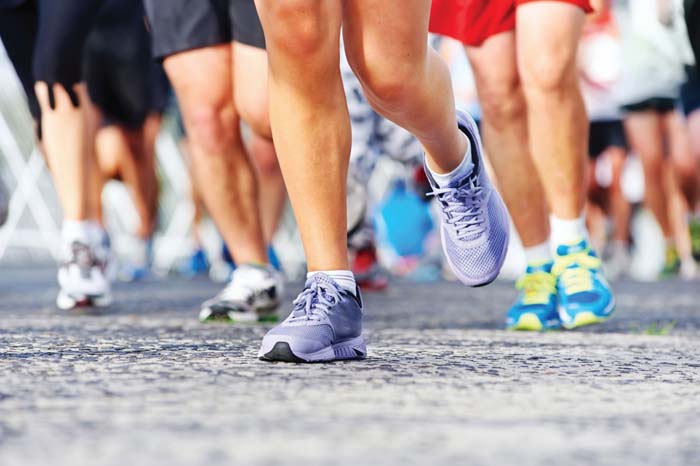There’s nothing better than hanging out with friends and having fun—chasing each other in the playground, running together in the park, or racing around on your bikes. And keeping active isn’t just fun, it’s good for you as well! Did you know that medical experts around the world recommend that kids and teenagers exercise at least an hour a day, five days a week?

And there are lots of different ways you can do it, depending on what you enjoy.
You might like taking lessons each week for your team sport of choice or swimming laps in the pool. Maybe smashing your serve on the tennis court is what gets you going or you prefer spending time perfecting your kata at karate class instead. Whether you’re dribbling the ball on the school football team, tackling and scoring tries at the rugby club, or shooting hoops with your mates, check out these fitness tips that will help keep you safe and strong, whatever sport you choose!
Eat before exercise (nutrition)
I’m sure you’re already dreaming of that post-match burger, but before you start exercising, it’s important to make sure you have enough fuel to fire you through your fitness session. If you want to perform and build strength, it’s essential to eat a variety of foods to make sure you have a balanced diet. This means that each day, you need carbohydrates, proteins, fats, fruits and vegetables.
You should eat regular meals and have a healthy snack at least 30 minutes before exercise. If you have a long training session or a sports tournament, don’t forget to take a snack with you. Fresh orange slices are deliciously refreshing (especially in the heat!), and bananas are great for instant energy—they’re also the favourite snack for many world-class athletes.
Drink plenty of water (hydration)
You need to drink plenty of water because as soon as you start running around, you will begin to feel thirsty. Also, in Qatar’s hot climate, you need to be careful to make sure you are well-hydrated before exercising. A glass of milk (containing protein, B-vitamins, iodine and calcium) or fruit juice (containing vitamins and minerals) are both ideal pre-sports drinks. Energy drinks aren’t generally a good idea as they contain a lot of caffeine and are often loaded with sugar.
Without a doubt, water is the best drink for hydration, and you need to be drinking one to two litres (around six to eight glasses) of water a day. If you don’t drink enough water, you are unlikely to perform at your best, and you risk running out of energy, getting a headache, or feeling sick. You need to sip water regularly as you work out, so don’t forget your water bottle. If you drink enough before, during, and after exercise, you will feel, perform, and recover better.
Warm-up and cool down
Avoiding injury is key to getting fit and staying strong. All athletes warm-up, cool-down, and take care when working out to prevent doing damage to their bodies. There’s a reason that footballers on the bench jump around on the sidelines during a match! You should warm-up for around five minutes before playing sports. Yes, that’s right—the school PE teachers know what they’re talking about when they send you for a few laps around the football pitch before a match! As well as preventing injury, a proper warm-up improves performance—and we all want to win!
After exercise you should cool-down to help your body recover and prevent stiff muscles, aches, and pains. Any exercise that slows down your heart rate is a good start, such as jogging or brisk walking. After that, it is important to stretch properly to avoid injuries. Your coach will show you a stretching routine for you to follow. A few basic stretches include:
- Reaching for the sky – stand up tall (on your tiptoes for this one) with your arms above your head, elbows touching your ears and reach as high as you can.
- Side stretches – stand up tall, with your arms straight above your head, elbows touching your ears, join your hands and slowly stretch, leaning to the right and then to the left.
- Touch your toes – stand up tall with your arms straight above your head, bend forward from the hips and keep your legs straight. Now try to touch your toes!
Wear the correct kit
Whatever sport you play, you need to use appropriate protective equipment and think about safety to minimise your risk of injury. What you need will depend on your chosen activity or exercise. You will need a pair of trainers for most sports and depending on the type of pitch, special boots for sports like football and rugby. This is to protect your feet, support your ankles, and to stop you from slipping over. Protective equipment is needed for other sports, and your coach will tell you what you need.
For example, you’ll need a helmet and pads if you’re batting on the cricket pitch, shin pads if you’re playing football, and a gum shield if you are playing rugby or hockey. When you’re cycling, scooting, or skateboarding, make sure you wear a helmet.

Listen to your coach
Sports coaches are experts, and if you want to be the best, you need to take their advice. Tell them about any medical conditions before you start and tell them if you feel too hot, exhausted, faint, or have any pain at all when you exercise. Follow instructions and stick to the training schedule by turning up regularly to practice sessions. If you’re picked for a team, make sure you are match or competition ready and not injured before the big day.
Have fun!
Exercise has so many health benefits for everyone. Getting fit means that you will build a stronger heart, bones, and healthier muscles. It can even help you to achieve better grades, feel less stressed out, and have better quality sleep. But don’t forget that playing sports is a great way of hanging out with your friends and having fun—so have fun!



